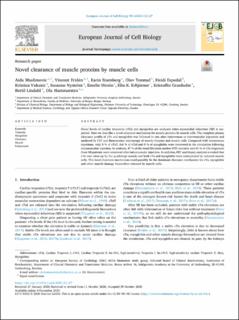| dc.contributor.author | Muslimovic, Aida | |
| dc.contributor.author | Friden, Vincent | |
| dc.contributor.author | Starnberg, Karin | |
| dc.contributor.author | Tenstad, Olav | |
| dc.contributor.author | Espedal, Heidi | |
| dc.contributor.author | Vukusic, Kristina | |
| dc.contributor.author | Nyström, Susanne | |
| dc.contributor.author | Wesén, Emelie | |
| dc.contributor.author | Esbjörner, Elin K | |
| dc.contributor.author | Granholm, Kristoffer | |
| dc.contributor.author | Lindahl, Bertil | |
| dc.contributor.author | Hammarsten, Ola | |
| dc.date.accessioned | 2021-06-29T15:55:54Z | |
| dc.date.available | 2021-06-29T15:55:54Z | |
| dc.date.created | 2021-02-15T11:26:09Z | |
| dc.date.issued | 2020 | |
| dc.identifier.issn | 0171-9335 | |
| dc.identifier.uri | https://hdl.handle.net/11250/2762421 | |
| dc.description.abstract | Blood levels of cardiac troponins (cTn) and myoglobin are analysed when myocardial infarction (MI) is suspected. Here we describe a novel clearance mechanism for muscle proteins by muscle cells. The complete plasma clearance profile of cTn and myoglobin was followed in rats after intravenous or intermuscular injections and analysed by PET and fluorescence microscopy of muscle biopsies and muscle cells. Compared with intravenous injections, only 5 % of cTnT, 0.6 % of cTnI and 8 % of myoglobin were recovered in the circulation following intramuscular injection. In contrast, 47 % of the renal filtration marker FITC-sinistrin and 81 % of cTn fragments from MI-patients were recovered after intramuscular injection. In addition, PET and biopsy analysis revealed that cTn was taken up by the quadriceps muscle and both cTn and myoglobin were endocytosed by cultured muscle cells. This local clearance mechanism could possibly be the dominant clearance mechanism for cTn, myoglobin and other muscle damage biomarkers released by muscle cells. | en_US |
| dc.language.iso | eng | en_US |
| dc.publisher | Elsevier | en_US |
| dc.rights | Attribution-NonCommercial-NoDerivatives 4.0 Internasjonal | * |
| dc.rights.uri | http://creativecommons.org/licenses/by-nc-nd/4.0/deed.no | * |
| dc.title | Novel clearance of muscle proteins by muscle cells | en_US |
| dc.type | Journal article | en_US |
| dc.type | Peer reviewed | en_US |
| dc.description.version | publishedVersion | en_US |
| dc.rights.holder | Copyright 2020 Elsevier GmbH. | en_US |
| dc.source.articlenumber | 151127 | en_US |
| cristin.ispublished | true | |
| cristin.fulltext | original | |
| cristin.qualitycode | 1 | |
| dc.identifier.doi | 10.1016/j.ejcb.2020.151127 | |
| dc.identifier.cristin | 1889793 | |
| dc.source.journal | European Journal of Cell Biology | en_US |
| dc.relation.project | Helse Vest RHF: 911974 | en_US |
| dc.identifier.citation | European Journal of Cell Biology. 2020, 99 (8), 151127 | en_US |
| dc.source.volume | 99 | en_US |
| dc.source.issue | 8 | en_US |

